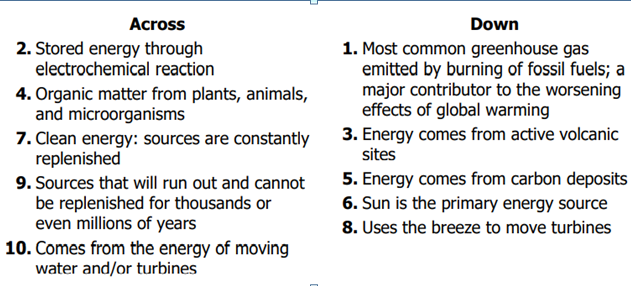Across Down 2. Stored energy through electrochemical reaction 4. Organic matter from plants, animals, and microorganisms 7. Clean energy: sources are constantly replenished 1. Most common greenhouse gas emitted by burning of fossil fuels; a major contributor to the worsening effects of global warming 3. Energy comes from active volcanic sites 9. Sources that will run out and cannot be replenished for thousands or even millions of years 10. Comes from the energy of moving water and/or turbines 5. Energy comes from carbon deposits 6. Sun is the primary energy source 8. Uses the breeze to move turbines
Across Down 2. Stored energy through electrochemical reaction 4. Organic matter from plants, animals, and microorganisms 7. Clean energy: sources are constantly replenished 1. Most common greenhouse gas emitted by burning of fossil fuels; a major contributor to the worsening effects of global warming 3. Energy comes from active volcanic sites 9. Sources that will run out and cannot be replenished for thousands or even millions of years 10. Comes from the energy of moving water and/or turbines 5. Energy comes from carbon deposits 6. Sun is the primary energy source 8. Uses the breeze to move turbines
Chemistry for Engineering Students
4th Edition
ISBN:9781337398909
Author:Lawrence S. Brown, Tom Holme
Publisher:Lawrence S. Brown, Tom Holme
Chapter9: Energy And Chemistry
Section: Chapter Questions
Problem 9.92PAE
Related questions
Question
answer the following:

Transcribed Image Text:Across
Down
2. Stored energy through
electrochemical reaction
1. Most common greenhouse gas
emitted by burning of fossil fuels; a
major contributor to the worsening
effects of global warming
3. Energy comes from active volcanic
sites
4. Organic matter from plants, animals,
and microorganisms
7. Clean energy: sources are constantly
replenished
9. Sources that will run out and cannot
be replenished for thousands or
even millions of years
10. Comes from the energy of moving
water and/or turbines
5. Energy comes from carbon deposits
6. Sun is the primary energy source
8. Uses the breeze to move turbines
Expert Solution
This question has been solved!
Explore an expertly crafted, step-by-step solution for a thorough understanding of key concepts.
Step by step
Solved in 4 steps

Knowledge Booster
Learn more about
Need a deep-dive on the concept behind this application? Look no further. Learn more about this topic, chemistry and related others by exploring similar questions and additional content below.Recommended textbooks for you

Chemistry for Engineering Students
Chemistry
ISBN:
9781337398909
Author:
Lawrence S. Brown, Tom Holme
Publisher:
Cengage Learning

EBK A SMALL SCALE APPROACH TO ORGANIC L
Chemistry
ISBN:
9781305446021
Author:
Lampman
Publisher:
CENGAGE LEARNING - CONSIGNMENT

Chemistry & Chemical Reactivity
Chemistry
ISBN:
9781337399074
Author:
John C. Kotz, Paul M. Treichel, John Townsend, David Treichel
Publisher:
Cengage Learning

Chemistry for Engineering Students
Chemistry
ISBN:
9781337398909
Author:
Lawrence S. Brown, Tom Holme
Publisher:
Cengage Learning

EBK A SMALL SCALE APPROACH TO ORGANIC L
Chemistry
ISBN:
9781305446021
Author:
Lampman
Publisher:
CENGAGE LEARNING - CONSIGNMENT

Chemistry & Chemical Reactivity
Chemistry
ISBN:
9781337399074
Author:
John C. Kotz, Paul M. Treichel, John Townsend, David Treichel
Publisher:
Cengage Learning

Chemistry & Chemical Reactivity
Chemistry
ISBN:
9781133949640
Author:
John C. Kotz, Paul M. Treichel, John Townsend, David Treichel
Publisher:
Cengage Learning

Chemistry by OpenStax (2015-05-04)
Chemistry
ISBN:
9781938168390
Author:
Klaus Theopold, Richard H Langley, Paul Flowers, William R. Robinson, Mark Blaser
Publisher:
OpenStax

Chemistry: Principles and Reactions
Chemistry
ISBN:
9781305079373
Author:
William L. Masterton, Cecile N. Hurley
Publisher:
Cengage Learning